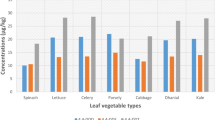Abstract
Degradation-resistant chemical contaminants of health concern such as dichlorodiphenyltrichloroethane (DDT) pesticides and polychlorinated biphenyls (PCBs) in the environment are redistributed between different environmental compartments, where they partition between biotic heterotrophic routes and abiotic features (water and immobile soil components). Their fate and the potential risk they pose is a function of translocation, interaction, environmental behavior, and bio-translation/activities. In this study, the partitioning, translocation, bio-translation pathways of 3-DDT and 6-PCB congeners in dosed soils cultured root and leaf vegetables were investigated to predict their soil–vegetable mobility, depuration, and exposure risk. Results showed that PCB_110 and PCB_180 were the least and highest PCBs concentrated in both the leaf and root vegetables. The variations in the 3-DDT and 6-PCB concentrations in the leaf and root vegetables may be attributed to differences in their solubility and partitioning. Total residual mass fraction 3-DDT taken up by the leaf and root vegetables indicated time-dependent preferentiality in pesticide-type vascular tissue translocation to the vegetables. Mann–Whitney non-parametric test showed evidence of spatial variations in levels of the 3-DDT and 6-PCBs across the farmland; however, the variations in the distribution were not significant (PFML1–FML6 <<Pstat). Risk factors for 3-PCBs and 3-DDT tend to 1(f < 1.0), while that for PCBs_149, 153, and _180 were far less than 0.4 (<1.0). It is therefore uncertain that any immediate health risks could arise from exposure to vegetables containing such congener levels. Continuous exposure to an extrapolated estimate of 25% vegetable population has a 20 ± 10% probability of leading to undesirable chronic effects.
Similar content being viewed by others
References
Acin-Carrera, M., Jose Marques, M., Carral, P., Alvarez, A. M., Lopez, C., Martin-Lopez, B., & Gonzalez, J. A. (2013). Impacts of land-use intensity on soil organic carbon content, soil structure and water-holding capacity. Soil Use Management, 29, 547–556.
Corwin, D. L., & Lesch, S. (2003). Application of soil electrical conductivity to precision agriculture. Agronomy Journal, 95(3), 455–471.
CSIRO (2018) (http://www.csiro.au/Outcomes/Environment/Australian-Landscapes/soil-carbon.aspx). Archived on the 23 August, 2019.
Dorne, J. L. C. M., Bordajandi, L. R., Amzal, B., Ferrari, P., & Verger, P. (2009). Combining analytical techniques, exposure assessment and biological effects for risk assessment of chemicals in food. TrAC Trends Anal. Chem., 28(6, 695–707.
Folk, R. L. (1980). Petrology of sedimentary rocks (84 p). Austin: Hemphill Publishing Company.
Grossberger, A., Hadar, Y., Borch, T., & Chefetz, B. (2014). Biodegradability of pharmaceutical compounds in agricultural soils irrigated with treated wastewater. Environmental Pollution, 185C, 168–177.
Horneck DA, Sullivan DM, Owen JS, Hart JM (2011) Soil test interpretation guide. EC 1478. Oregon State University extension service. Originally published august 1996. Revised July 2011.
IARC. (2016). Polychlorinated biphenyls and polybrominated biphenyls. IARC monographs on the evaluation of carcinogenic risks to humans, no. 107. IARC working group on the evaluation of carcinogenic risk to humans. Lyon (FR): International Agency for Research on Cancer.
Jayaraj, R., Megha, P., & Sreedev, P. (2016). Organochlorine pesticides, their toxic effects on living organisms and their fate in the environment: review. Interdisciplinary Toxicology, 9(3–4), 90–100.
Kampire, E., Rubidge, G., & Adams, J. B. (2017). Characterization of polychlorinated biphenyls in surface sediments of the North End Lake, Port Elizabeth, South Africa. Water SA, 43(4), 646–654.
Karas, P., Metsoviti, A., Zisis, V., Ehaliotis, C., Omirou, M., Papadopoulou, E. S., Menkissoglou-Spiroudi, U., Manta, S., Komiotis, D., & Karpouzas, D. G. (2015). Dissipation, metabolism and sorption of pesticides used in fruit-packaging plants: towards an optimized depuration of their pesticide-contaminated agro-industrial effluents. Science of the Total Environment, 530–531, 129–139.
Khoiyangbam RS, Gupta N (2015) Introduction to environmental sciences. Published by “The Energy and Resources Institute, TERI, 2015. ISBN 10: 8179934551
Kleinman, P. J. A., Sharpley, A. N., Gartley, K., Jarrell, W. M., Kuo, S., Menon, R. G., Myers, R., Reddy, K. R., & Skogley, E. O. (2001). Interlaboratory comparison of soil phosphorus extracted by various soil test methods. Communications in Soil Science and Plant Analysis, 32, 2325–2345.
Lawal, A. T. (2017). Polycyclic aromatic hydrocarbons. A review. Cogent Environmental Science, 3(1), 1339841–1339930.
Li, X., Wang, X., Zhao, Q., Zhang, Y., & Zhou, Q. (2016). In situ representation of soil/sediment conductivity using electrochemical impedance spectroscopy. Sensors, 16, 625–634.
NRC (National Research Council), & NAS (National Academy of Science). (1983). Risk assessment in the federal government: Managing the process (p. 191). Washington D.C.: National Academy Press.
Neuwirthová, N., Trojan, M., Svobodová, M., Vašíčková, J., Šimek, Z., Hofman, J., & Bielská, L. (2019). Pesticide residues remaining in soils from previous growing season(s) - Can they accumulate in non-target organisms and contaminate the food web? Science of the Total Environment, 646, 1056–1062.
Odukkathil, G., & Vasudevan, N. (2013). Toxicity and bioremediation of pesticides in agricultural soil. Reviews in Environmental Science and Biotechnology, 12, 421–444.
Olatunji, O. S. (2019). Evaluation of selected polychlorinated biphenyls (PCBs) congeners and dichlorodiphenyltrichloroethane (DDT) in fresh root and leafy vegetables using GC-MS. Scientific Reports, 9(1), 538–547.
Olatunji, O. S., Ximba, B. J., Fatoki, O. S., & Opeolu, B. O. (2014). Assessment of the phytoremediation potential of Panicum maximum (Guinea grass) for selected heavy metal removal from contaminated soils. African Journal of Biotechnology, 13(19), 1979–1984.
Penn, C. J., & Camberato, J. J. (2019). A critical review on soil chemical processes that control how soil pH affects phosphorus availability to plant. Agriculture, 9(120), 1–18.
Pérez-Lucas G, Vela N, El Aatik A, Navarro S, (2018) Environmental risk of groundwater pollution by pesticide leaching through the soil profile Book chapter in “Pesticides - Use and Misuse and Their Impact in the Environment” https://doi.org/10.5772/intechopen.82418.
PAN (Pesticides Action Network of UK) (2017) https://www.pan-uk.org/health-effects-of-pesticides/. Achieved on November 19, 2019.
Poppe LJ, Eliason AH, Fredericks JJ, Rendigs RR, Blackwood D, Polloni CF (2000) Chapter 1: grain-size analysis of marine sediments: methodology and data processing. U.S. Geological Survey Open-file Report 00–358 (https://pubs.usgs.gov/of/2000/of00-358/text/chapter1.htm).
Providenti, M. A., Lee, H., & Trevors, J. T. (1993). Selected factors limiting the microbial degradation of recalcitrant compounds. Journal of Industrial Microbiology, 12(6), 379–395.
Quevauviller, P., Ure, A., Muntau, H., & Griepink, B. (2006). Improvement of analytical measurements within the BCR-programme: single and sequential extraction procedures applied to soil and sediment analysis. International Journal of Environmental Analytical Chemistry, 51(1–4), 129–134.
Rodríguez-Eugenio N, McLaughlin M, Pennock D (2018) Soil pollution: a hidden reality. FAO. 142 pp. published by the food and agricultural Organization of the United Nations (FAO), Rome, 2018
Scharf, P., & Alley, M. M. (1988). Centrifugation: a solution to the problem posed by ammonium and nitrate contamination of filters in soil extract analysis. Soil Science Society of America Journal, 52, 1508–1510.
Schumacher BA (2002) Methods for the determination of total organic carbon (TOC) in soils and sediments. U.S. Environmental Protection Agency, Washington, DC, EPA/600/R-02/069 (NTIS PB2003-100822).
Stadler, A., Rudolph, S., Kupisch, M., Langensiepen, M., Van der Kruk, J., & Ewert, F. (2015). Quantifying the effect of soil variability on crop growth using apparent soil electrical conductivity measurements. European Journal of Agronomy, 64, 8–20.
US EPA (2004a) Endangered and Threatened Species Effects Determinations: Overview of the Ecological Risk Assessment Process in the Office of Pesticide Programs, U.S. Environmental Protection Agency. Office of Prevention, Pesticides and Toxic Substances Office of Pesticide Programs Washington, D.C. January 23, 2004.
US EPA. (2004b). Risk based concentration table. InIntegrated risk information system (IRIS) (Vol. 2004). Philadelphia, PA: United States Environmental Protection Agency, Washington D.C.
Utermann, J., Kladivko, E. J., & Jury, W. A. (1990). Evaluating pesticide migration in tile-drained soils with a transfer function model. Journal of Environmental Quality, 19(4), 707–714.
Velde B, Meunier A (2008) The origin of clay minerals in soils and weathered rocks. Published by Springer, Berlin, Heidelberg. Springer-Verlag Berlin Heidelberg 2008 https://doi.org/10.1007/978-3-540-75634-7.
Walkley, A. & Black, I.A. (1934). An examination of Degtjareff method for determining soil organic matter, and proposed modification of the chromic acid titation method. Soil Science 37:29–38.
Weeks Jr., J. J., & Hettiarachchi, G. M. (2019). A review of the latest in phosphorus fertilizer technology: possibilities and pragmatism. Journal of Environmental Quality Special Section, 48(5), 1300–1313.
Williams, C. F., Agassi, M., Letey, J., Farmer, W. J., Nelson, S. D., & Ben-Hur, M. (2000). Facilitated transport of napropamide by dissolved organic matter through soil columns. Soil Science Society of America Journal, 64, 590–594.
Yu, Y., Liu, Y., & Wu, L. (2013). Sorption and degradation of pharmaceuticals and personal care products (PPCPs) in soils. Environmental Science and Pollution Research, 20(6), 4261–4267.
Zhao, S. C., Huang, S. W., Qiu, S. J., & He, P. (2018). Response of soil organic carbon fractions to increasing rates of crop residue return in a wheat–maize cropping system in north-central China. Soil Research, 56(8), 856–864.
Author information
Authors and Affiliations
Corresponding author
Additional information
Publisher’s Note
Springer Nature remains neutral with regard to jurisdictional claims in published maps and institutional affiliations.
Rights and permissions
About this article
Cite this article
Olatunji, O.S. Partitioning, Translocation Pathways and Environmental Risk Evaluation of Selected Polychlorinated Biphenyls and Pesticides. Water Air Soil Pollut 231, 407 (2020). https://doi.org/10.1007/s11270-020-04771-z
Received:
Accepted:
Published:
DOI: https://doi.org/10.1007/s11270-020-04771-z




